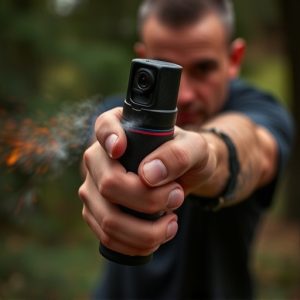Capsaicin-Based Self-Defense: Unveiling Low Light Pepper Spray Tactics
Capsaicin, the active ingredient in chili peppers, offers a non-lethal self-defense solution through…….
Capsaicin, the active ingredient in chili peppers, offers a non-lethal self-defense solution through low light pepper spray. This compound binds to receptors in eyes, nose, and skin, causing intense irritation. Designing a capsaicin device requires careful formulation for stability and potency, optimized spray pattern and range, an easy trigger mechanism, compact design, robust construction, and compliance with local laws. Low Light Pepper Spray Tactics enhance its effectiveness in dimly lit or dark environments, providing a discrete and effective personal protection solution without alerting threats.
“Discover the power of nature’s defense mechanism with our innovative focus on capsacinoid chemistry for personal safety. This article explores how understanding capsaicin, the active ingredient in chili peppers, can revolutionize self-defense strategies. We delve into designing a cutting-edge personal protection device, highlighting key considerations for maximum effectiveness. Furthermore, we examine tactical applications of low light pepper spray, offering unique techniques for enhancing safety in dark or confined spaces, catering to both individuals and law enforcement.”
- Understanding Capsaicin and Its Effects for Self-Defense
- Designing a Personal Protection Device: Key Considerations
- Tactical Applications of Low Light Pepper Spray
Understanding Capsaicin and Its Effects for Self-Defense
Capsaicin, the active ingredient in chili peppers, has been a subject of interest for self-defense applications due to its powerful effects on the human sense of touch and smell. When incorporated into personal protection devices like low light pepper spray, capsaicin can provide individuals with an effective and non-lethal way to deter potential threats. Its main mechanism of action involves binding to specific receptors in the eyes, nose, and skin, leading to intense irritation and pain.
In low light or dark situations, where traditional pepper spray might be less effective, capsaicin-based devices offer a unique advantage. This ingredient’s ability to induce tears, temporary blindness, and intense discomfort can give users crucial seconds to escape or summon help. Understanding the power of capsaicin allows individuals to employ creative tactics, such as targeting sensitive areas like eyes and airways, ensuring its maximum impact during self-defense situations.
Designing a Personal Protection Device: Key Considerations
Designing a personal protection device incorporating capsaicin, the active ingredient in chili peppers, requires careful consideration of several factors to ensure its effectiveness and user-friendliness. One key aspect is the formulation process; creating a stable and potent capsaicin solution that can be effectively dispensed is crucial. This involves selecting appropriate carriers and additives to optimize both the spray pattern and the range, ensuring it works in low light conditions as well as during daylight hours using Low Light Pepper Spray Tactics.
The device’s design should prioritize user safety and convenience. This includes implementing features like an easy-to-activate trigger mechanism, a compact and ergonomic shape for one-handed use, and a robust construction to withstand tough environments. Additionally, considering the legal implications and regulations surrounding pepper spray products is essential, ensuring compliance with local laws and standards to provide users with peace of mind and legal protection.
Tactical Applications of Low Light Pepper Spray
Low light pepper spray tactics have gained significant importance in tactical operations, offering a discreet and effective personal protection solution. Unlike traditional pepper spray, designed for optimal visibility, low light varieties are specially formulated to create a potent irritant that works even in dimly lit or complete darkness scenarios. This subtle yet powerful tool is invaluable in tactical situations where stealth is crucial.
Tactical operators can use low light pepper spray to disrupt and disorient potential threats without alerting them. Its non-lethal nature allows for the control and de-escalation of high-risk situations, providing an additional layer of safety during close-quarters combat or when navigating unfamiliar and poorly lit environments. The ability to deploy this spray discreetly can significantly enhance operational success rates while minimizing collateral damage and ensuring the safety of both the user and civilians.
The development of a capsaicin-based personal protection device, particularly one designed for low light environments, offers innovative self-defense options. By understanding the power of capsaicin and its effects, we can create effective tools that provide individuals with enhanced safety in various scenarios. The tactical applications of low light pepper spray are vast, offering a non-lethal means to deter aggression and ensure personal security. With further research and design advancements, these devices could become indispensable for those seeking proactive protection in their daily lives.

